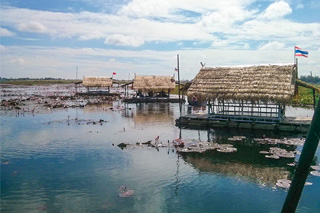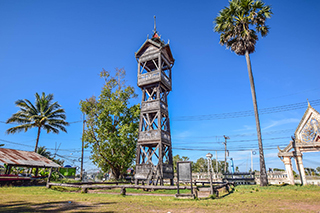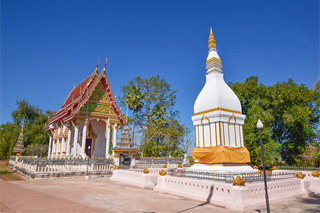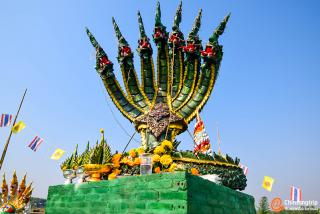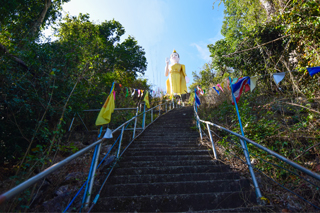"Phra That Don Kaeo" or Don Kaeo Temple, is one of the sacred and historically significant places in the Udon Thani province of Thailand. Situated at Ban Don Kaeo in the Kum Pu Wapi district, the special feature of "Phra That Don Kaeo" goes beyond being a grand pagoda. It is located in a natural and expansive area on a small island in the middle of the Nong Han swamp of the Kum Pu Wapi district, Thailand.
However, not only that, the surrounding area of "Phra That Don Kaeo" is also the origin of the Lam Pao River, a river of great importance to the daily lives of the communities in the sub-district. The topography of the island is circular and surrounded by water, creating a diverse and picturesque natural environment. The terrain within the island includes hills of varying heights, leading to the construction of the Phra That Don Kaeo on an elevated platform. The surrounding environment is lush, and the panoramic views are breathtaking. These factors contribute to making "Phra That Don Kaeo" a significant and valuable tourist destination in the Udon Thani province.

Legend of Phra That Doi Kaeo
The legend tells of a group of pilgrims heading to worship the Phra That Phanom stupa. While on their journey, they stopped to rest at the Doi Kaeo Island, also known as "Phra That Doi Kaeo." This area is considered highly sacred, as one of the pilgrims had met with a tragic death due to a curse on this island. The surviving pilgrims then performed a cremation ceremony and erected a stupa to enshrine the sacred relic in honor of the deceased.
In ancient times, another group of people entered the Doi Kaeo region and constructed a sandstone boundary around the Phra That Phanom stupa. Through research, it was found that this boundary was built during the Dvaravati period. Later, the Lao community migrated from Roi Et and Chaiyaphum to establish a settlement at Doi Kaeo. Historical inscriptions at the base of the stupa, written in ancient Lao script, indicated that Thao Chin was the leader of the community. He performed the consecration ceremony and completed the construction in the year 2441 B.E.
In the year 2471 B.E., Laotian communities from Vientiane arrived at Doi Kaeo and built a temple named "Wat Maha That Chedi" to serve as a central place for religious ceremonies. In 2513 B.E., Phra Khru Sangkharak (Chon), the abbot of the temple, collaborated with the locals of Doi Kaeo to renovate and strengthen the Phra That stupa through a consecration ceremony. Additionally, archaeological studies conducted by Silpakorn University revealed that the age of Phra That Chedi is at least 1,500 years, and the surrounding boundary stones date back to ancient times.

Traveling to Phra That Doi Kong
If you are traveling to Udon Thani province and using Highway 2 that connects Udon Thani and Khon Kaen, you will encounter an interesting route leading to Phra That Doi Kong Mu. As you immerse yourself in the ambiance of the Kumphawapi district, don´t forget to make a left turn into the Kumphawapi district, which is only 15 kilometers away from the main highway. Upon reaching the district, you can proceed to reach Doi Kong Mu, which is just about 1 kilometer away. Here, you will discover the sacred "Phra That Doi Kong Mu," a geographical landmark.
Afterward, you can take a short trip to the Red Lotus Sea without spending much time. You can easily reach Phra That Doi Kong Mu through the newly constructed route around Nong Han Kumphawapi. This route will lead you to Phra That Doi Kong Mu effortlessly and conveniently.
"Phra That Don Kaeo" or Don Kaeo Temple, is one of the sacred and historically significant places in the Udon Thani province of Thailand. Situated at Ban Don Kaeo in the Kum Pu Wapi district, the special feature of "Phra That Don Kaeo" goes beyond being a grand pagoda. It is located in a natural and expansive area on a small island in the middle of the Nong Han swamp of the Kum Pu Wapi district, Thailand.
However, not only that, the surrounding area of "Phra That Don Kaeo" is also the origin of the Lam Pao River, a river of great importance to the daily lives of the communities in the sub-district. The topography of the island is circular and surrounded by water, creating a diverse and picturesque natural environment. The terrain within the island includes hills of varying heights, leading to the construction of the Phra That Don Kaeo on an elevated platform. The surrounding environment is lush, and the panoramic views are breathtaking. These factors contribute to making "Phra That Don Kaeo" a significant and valuable tourist destination in the Udon Thani province.

Legend of Phra That Doi Kaeo
The legend tells of a group of pilgrims heading to worship the Phra That Phanom stupa. While on their journey, they stopped to rest at the Doi Kaeo Island, also known as "Phra That Doi Kaeo." This area is considered highly sacred, as one of the pilgrims had met with a tragic death due to a curse on this island. The surviving pilgrims then performed a cremation ceremony and erected a stupa to enshrine the sacred relic in honor of the deceased.
In ancient times, another group of people entered the Doi Kaeo region and constructed a sandstone boundary around the Phra That Phanom stupa. Through research, it was found that this boundary was built during the Dvaravati period. Later, the Lao community migrated from Roi Et and Chaiyaphum to establish a settlement at Doi Kaeo. Historical inscriptions at the base of the stupa, written in ancient Lao script, indicated that Thao Chin was the leader of the community. He performed the consecration ceremony and completed the construction in the year 2441 B.E.
In the year 2471 B.E., Laotian communities from Vientiane arrived at Doi Kaeo and built a temple named "Wat Maha That Chedi" to serve as a central place for religious ceremonies. In 2513 B.E., Phra Khru Sangkharak (Chon), the abbot of the temple, collaborated with the locals of Doi Kaeo to renovate and strengthen the Phra That stupa through a consecration ceremony. Additionally, archaeological studies conducted by Silpakorn University revealed that the age of Phra That Chedi is at least 1,500 years, and the surrounding boundary stones date back to ancient times.

Traveling to Phra That Doi Kong
If you are traveling to Udon Thani province and using Highway 2 that connects Udon Thani and Khon Kaen, you will encounter an interesting route leading to Phra That Doi Kong Mu. As you immerse yourself in the ambiance of the Kumphawapi district, don´t forget to make a left turn into the Kumphawapi district, which is only 15 kilometers away from the main highway. Upon reaching the district, you can proceed to reach Doi Kong Mu, which is just about 1 kilometer away. Here, you will discover the sacred "Phra That Doi Kong Mu," a geographical landmark.
Afterward, you can take a short trip to the Red Lotus Sea without spending much time. You can easily reach Phra That Doi Kong Mu through the newly constructed route around Nong Han Kumphawapi. This route will lead you to Phra That Doi Kong Mu effortlessly and conveniently.


